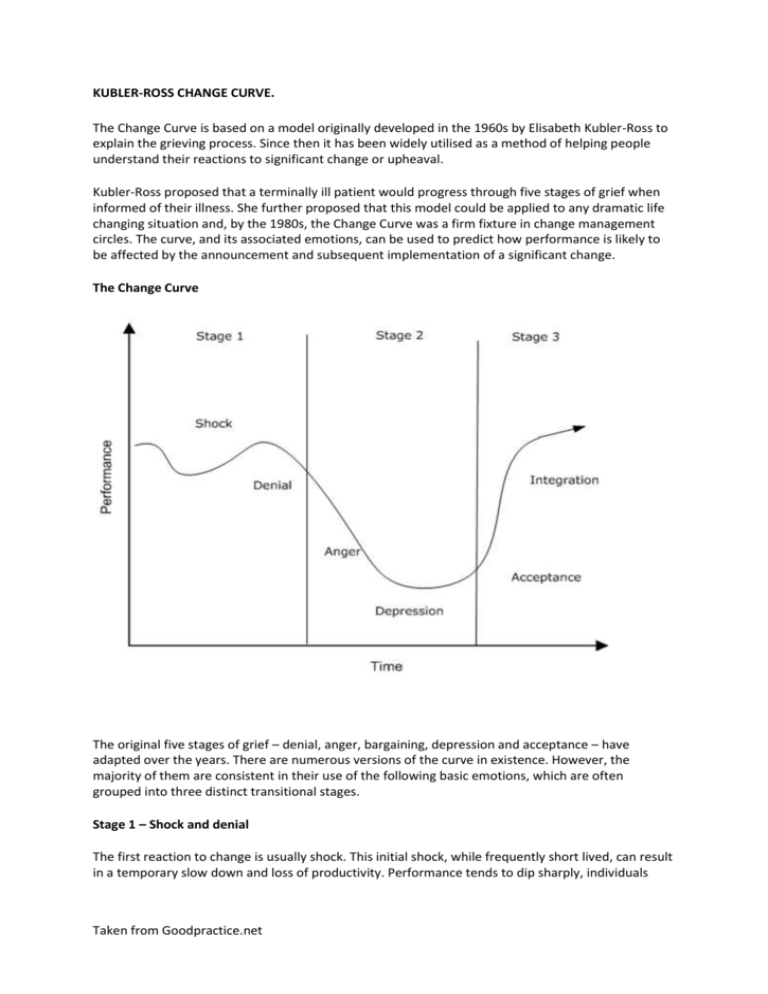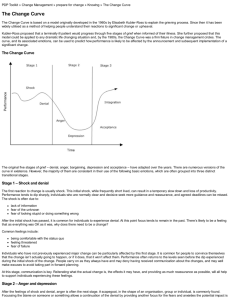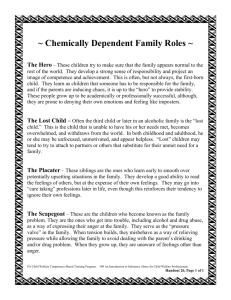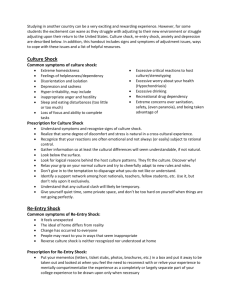Kubler Ross Change Curve
advertisement

KUBLER-ROSS CHANGE CURVE. The Change Curve is based on a model originally developed in the 1960s by Elisabeth Kubler-Ross to explain the grieving process. Since then it has been widely utilised as a method of helping people understand their reactions to significant change or upheaval. Kubler-Ross proposed that a terminally ill patient would progress through five stages of grief when informed of their illness. She further proposed that this model could be applied to any dramatic life changing situation and, by the 1980s, the Change Curve was a firm fixture in change management circles. The curve, and its associated emotions, can be used to predict how performance is likely to be affected by the announcement and subsequent implementation of a significant change. The Change Curve The original five stages of grief – denial, anger, bargaining, depression and acceptance – have adapted over the years. There are numerous versions of the curve in existence. However, the majority of them are consistent in their use of the following basic emotions, which are often grouped into three distinct transitional stages. Stage 1 – Shock and denial The first reaction to change is usually shock. This initial shock, while frequently short lived, can result in a temporary slow down and loss of productivity. Performance tends to dip sharply, individuals Taken from Goodpractice.net who are normally clear and decisive seek more guidance and reassurance, and agreed deadlines can be missed. The shock is often due to: lack of information fear of the unknown fear of looking stupid or doing something wrong After the initial shock has passed, it is common for individuals to experience denial. At this point focus tends to remain in the past. There’s likely to be a feeling that as everything was OK as it was, why does there need to be a change? Common feelings include: being comfortable with the status quo feeling threatened fear of failure Individuals who have not previously experienced major change can be particularly affected by this first stage. It is common for people to convince themselves that the change isn’t actually going to happen, or if it does, that it won’t affect them. Performance often returns to the levels seen before the dip experienced during the initial shock of the change. People carry on as they always have and may deny having received communication about the changes, and may well make excuses to avoid taking part in forward planning. At this stage, communication is key. Reiterating what the actual change is, the effects it may have, and providing as much reassurance as possible, will all help to support individuals experiencing these feelings. Stage 2 – Anger and depression After the feelings of shock and denial, anger is often the next stage. A scapegoat, in the shape of an organisation, group or individual, is commonly found. Focussing the blame on someone or something allows a continuation of the denial by providing another focus for the fears and anxieties the potential impact is causing. Common feelings include: suspicion scepticism frustration The lowest point of the curve comes when the anger begins to wear off and the realisation that the change is genuine hits. It is common for morale to be low, and for self-doubt and anxiety levels to peak. Feelings during this stage can be hard to express, and depression is possible as the impact of what has been lost is acknowledged. This period can be associated with: apathy isolation remoteness At this point performance is at its lowest. There is a tendency to fixate on small issues or problems, often to the detriment of day to day tasks. Individuals may continue to perform tasks in the same way as before, even if this is no longer appropriate behaviour. Taken from Goodpractice.net People will be reassured by the knowledge that others are experiencing the same feelings. Providing managers, teams and individuals with information about the Change Curve underlines that the emotions are usual and shared, and this can help to develop a more stable platform from which to move into the final stage. Stage 3 – Acceptance and integration After the darker emotions of the second stage, a more optimistic and enthusiastic mood begins to emerge. Individuals accept that change is inevitable, and begin to work with the changes rather than against them. Now come thoughts of: exciting new opportunities relief that the change has been survived impatience for the change to be complete The final steps involve integration. The focus is firmly on the future and there is a sense that real progress can now be made. By the time everyone reaches this stage, the changed situation has firmly replaced the original and becomes the new reality. The primary feelings now include: acceptance hope trust During the early part of this stage, energy and productivity remain low, but slowly begin to show signs of recovery. Everyone will have lots of questions and be curious about possibilities and opportunities. Normal topics of conversation resume, and a wry humour is often used when referring to behaviour earlier in the process. Individuals will respond well to being given specific tasks or responsibilities, however communication remains key. Regular progress reports and praise help to cement the more buoyant mood. It is not uncommon for there to be a return to an earlier stage if the level of support suddenly drops. Individual reactions Each person reacts individually to change, and not all will experience every phase. Some people may spend a lot of time in stages 1 and 2, whilst others who are more accustomed to change may move fairly swiftly into stage 3. Although it is generally acknowledged that moving from stage 1 through stage 2 and finally to stage 3 is most common, there is no right or wrong sequence. Several people going through the same change at the same time are likely to travel at their own speed, and will reach each stage at different times. Summary The Change Curve is a very useful tool when managing individual or team change. Knowing where an individual is on the curve will help when deciding on how and when to communicate information, what level of support someone requires, and when best to implement final changes. Furnishing individuals with the knowledge that others understand and experience similar emotions is the best way to return, with as little pain as possible, to optimal performance. Taken from Goodpractice.net LEADERSHIP BEHAVIOURS REQUIRED TO SUPPORT AND GUIDE THROUGH CHANGE Stages 1– Shock and denial Potential feelings, responses, and behaviours seen Potential leadership behaviours and actions required Shock Explain the rationale. Fear Crying Deal with individual needs; don’t assume reactions will be the same for all. E.g. provide space, or be there with them. “I’m fine” Give time to let the message sink in. Initial relief Repeat, and repeat the message. “They’ll change their minds when they see sense.” Listen and listen. Show you understand their concerns. Find out what support or information someone might need initially. Take what actions you can to deal with immediate concerns. Be clear, in a supportive way, about what is nonnegotiable if anything. Provide as much information as you are able on the future and the plan to get there. Re-assure what you can re-assure on. Appreciate you may have had more time to come to terms with the change. “I’ll be fine” “This won’t / can’t last.” “I can keep going as I was.” Taken from Goodpractice.net Stage 2 – Anger and depression Anger Early involvement in how the change will happen. Bitterness Providing something that they can have control over. Betrayal Remove barriers wherever possible. Fear Worry Regular meeting to discuss issues and concerns, both with the team and individually. Scepticism Show you understand their concerns, but don’t promise anything you can’t deliver. Suspicion Be approachable, and make time for people. Exaggeration of stories Be honest and provide clarity. Self-doubt Feeling down and depressed Ask for and provide facts to keep the situation grounded in reality. Disruptive activity Ask what they need from you. Drop in performance levels. Ask what could be done; what could help; where would the benefits lie in the future. “Why should I bother?” Allow space to talk things over in a constructive fashion. What would have been a small issue becomes a big issue. Provide feedback and praise to keep people confident. Provide any relevant good news stories. Draw on those who can see things in a more positive light. Re-assure things will feel better in the future, and focus on their positive qualities that will help make the change. Taken from Goodpractice.net Stages 3 – Acceptance and Integration Insecure Re-assure of progress. Unskilled Recognise and feedback positives. Fear of others being better Understand and clarify the benefits Unsure Warily accepting Watch for slipping back to Anger and Depression, and have regular team meetings as well as 1:1s. Accepting it but not liking it. Be tenacious and stick to new ways of working. Putting up barriers. Provide training and allow time to learn new skills / ways of working. Getting there Nostalgic for the old times Being clear about new ways of working, and what’s not to be done any more. Starting to see the benefits come through Listening and taking actions to overcome barriers. Reflect back and show progress made in all aspects – tasks, how people are feeling. Involve and give ownership to making things work. Stay honest with what’s working and what’s not. Praise the progress made and feedback individual’s contributions. Celebrate the successes with all. Review and check understanding of new ways of working. Coaching to improve the successes gained. Provide greater responsibility and involvement to ensuring on-going success. Listening and taking actions to overcome final barriers. Be aware that people will reach these last stages at different times. Growing in confidence Forward thinking Making the change work. Taken from Goodpractice.net






